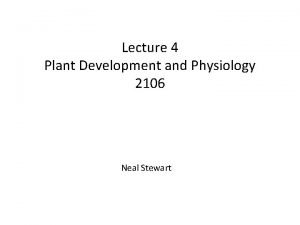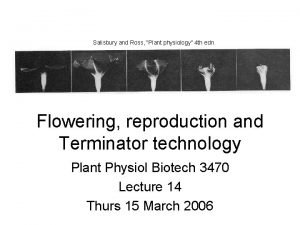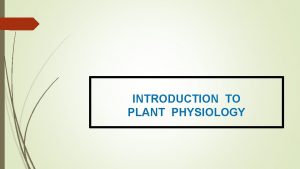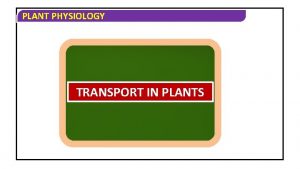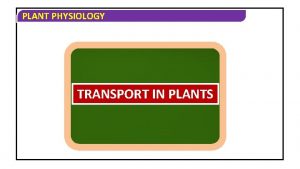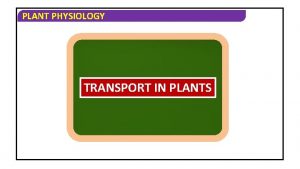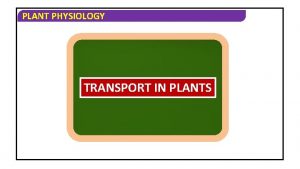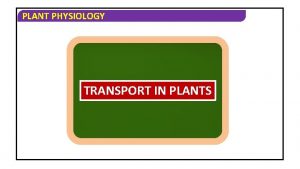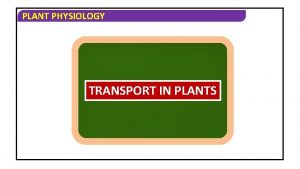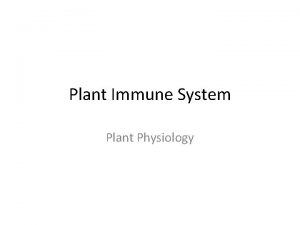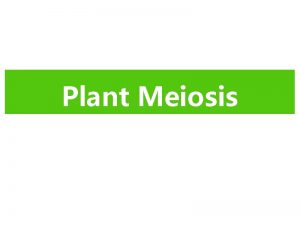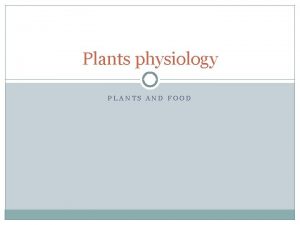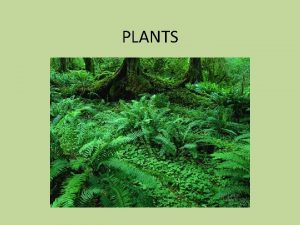PLANT PHYSIOLOGY Chapter 21 Plants Plants are very














- Slides: 14

PLANT PHYSIOLOGY Chapter 21

Plants • Plants are very important to all other life. • Just like other organisms, plants have organs, tissues and cells.

Plant Tissues • Plant Organs are made of four tissue systems • Dermal Tissue covers the outside of a plant. • Protects the plant • Secretes cuticle of leaves • Forms outer bark of trees • Ground Tissue is found inside a plant. • provides support • Stores materials in roots and stems • Meristematic Tissue consists of small, densely packed cells that can keep dividing to form new cells. • Allow cells to stay forever young • Involved in plant growth

Plant Tissues • Vascular Tissue transports water, minerals and organic compounds. • Made of two networks of hollow tubes • Xylem transports water and minerals • Phloem transports photosynthetic products (water and sugar) stem leaf root

Plant Organs • Just like other organisms, plants have organs which have specialized structures.

Roots • Roots make up over half the body of the plant and provide many functions: - anchor the plant to the ground -absorb water and minerals from the soil. • Parts of a root: • Root hairs are tiny projections on the dermal cells of roots that aid in absorption of water and minerals • Root cap – a small cone of cells that protects the growing part of the root as it pushes through the soil • Roots also include the xylem, phloem and cambium that aid in growth and movement of materials for photosynthesis and transpiration. root cap

Stems • Stems have many functions: • • • Support leaves and flowers House most of the vascular system Store water Grow underground for storage Form new plants Ginger rhizomes Cactus

Stems • Stems also include xylem, phloem and cambium which aid in growth, transpiration and photosynthesis.

Leaves • Leaves are the site of photosynthesis. • Absorb sunlight and carry out photosynthesis All leaves have the same structure and function. • The topside of the leaf is where the majority of the chloroplasts are located that absorb the sunlight. • The underside of the leaf contain the stomata and is the site of transpiration and gas exchange.

Leaves • Guard cells surround each stomata • Stomata open and close when guard cells change shape • When stomata are open, water evaporates and gas exchanges • Stomata close at night and when the plant loses too much water guard cells stomata

Flowers • Flowers are the reproductive structure of flowering plants. They protect gametes and fertilized eggs. Many parts make up the flower: • Sepal: modified leaves that protect the developing flower. • Petal: Modified leaves that are bright in color to attract animal pollinators.

Flowers Flower Parts cont’d: • Stamen: Male structure of flower. Includes the anther and the filament. • Anther – Produce pollen grains (sperm) • Filament – supports the anther. • Pistil (or carpel): Female structure of the flower. Includes the stigma, style and ovary. • Stigma- covered with sticky substance to hold pollen grains when they land. • Style- a tube that leads from stigma to ovary. • Ovary- Base of flower where the egg is produced.

Fruits • A fruit is the mature ovary of a flower. • It surrounds and protects the seed or seeds • Play an important role in seed dispersal. • Blown in the wind – ex. Dandelion • By animals ex. Stuck in animals fur or deposited after digestion • Can come in many forms

Cones • Cones are reproductive structures of plants that do not bear fruit. • Cones contain hard protective scales • Can be Male or Female: • Male cones contain pollen (sperm). • Eggs are produced in female cones. • Seeds also develop on the scales of female cones.
 Mikael ferm
Mikael ferm Very bad to very good scale
Very bad to very good scale Scientific notation rules
Scientific notation rules Fewfewfewf
Fewfewfewf It is a very shallow skillet with very short sloping sides
It is a very shallow skillet with very short sloping sides Quantifiers of food
Quantifiers of food Conducting tissue
Conducting tissue Plant celldiagram
Plant celldiagram Salisbury and ross plant physiology
Salisbury and ross plant physiology Plant introduction in plant breeding
Plant introduction in plant breeding Plant breeding for disease resistance
Plant breeding for disease resistance Plant introduction in plant breeding
Plant introduction in plant breeding Tronsmo plant pathology and plant diseases download
Tronsmo plant pathology and plant diseases download Tronsmo plant pathology and plant diseases download
Tronsmo plant pathology and plant diseases download Tronsmo plant pathology and plant diseases download
Tronsmo plant pathology and plant diseases download







